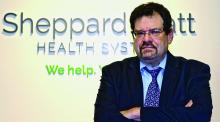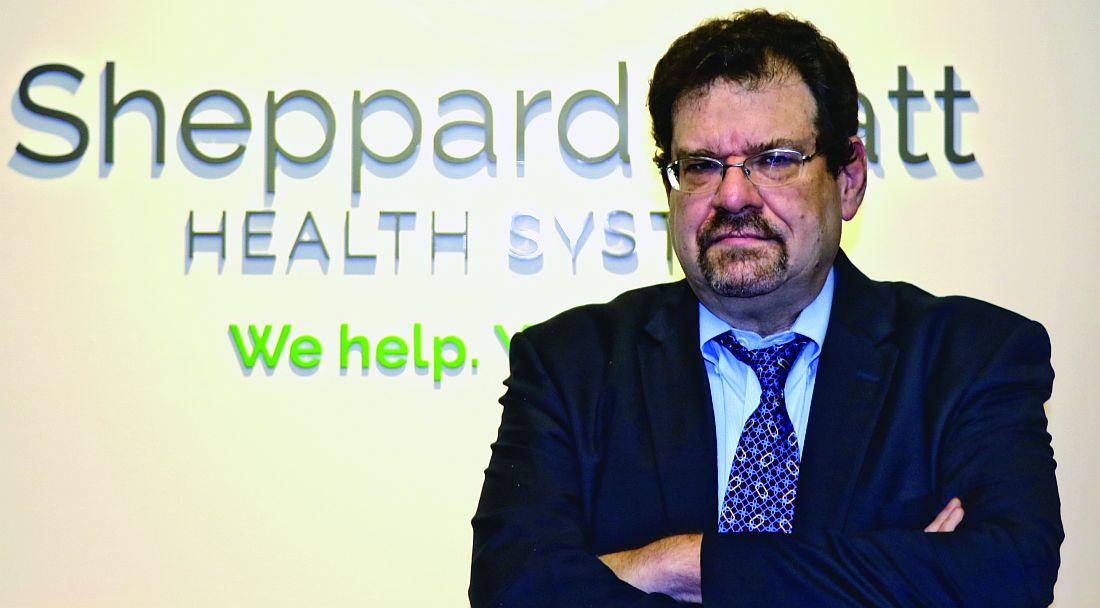User login
WASHINGTON – Successfully treating patients who have treatment-resistant depression (TRD) means leaving acute intervention behind and adopting more chronic remediation techniques, Scott T. Aaronson, MD, said at the annual conference of the Anxiety and Depression Association of America.
“We need to change the paradigm; most of the research is looking at a 6- to 12-week outcome measure,” said Dr. Aaronson, director of the clinical research program at Sheppard Pratt Health System, Baltimore. “These are folks who have been depressed for most of their adult lives, and we don’t tend to take a longer-term perspective when looking at this.”
Treatment-resistant depression, Dr. Aaronson said, can be conceptualized as two levels. The first is failure of two agents or treatments, and the second is a failure of four or more agents – including electroconvulsive therapy. In light of those levels, Dr. Aaronson suggests approaching depression as one would cancer, with different stages of failure determining payment for more expensive treatments.
Before planning how best to handle treatment-resistant depression, it is important for psychiatrists to understand its complexity, and address the issues associated with current psychiatric diagnoses, Dr. Aaronson said.
Diagnoses now are based purely on phenomenological analysis rather than biological analysis, he said. “Basically, it’s a room full of people getting together to decide what the diagnostic criteria are,” Dr. Aaronson said. “It’s eminence-based medicine, not evidence-based medicine.”
This approach creates a large gray area in which diagnoses can fall, making it more difficult to distinguish between bipolar and unipolar depression, as well as tough to distinguish psychotic and nonpsychotic illnesses.
If a patient displayed mood instability, for example, but not enough to fit the criteria of bipolar disorder, this scenario would present a dilemma for psychiatrists unable to diagnose the patient as bipolar and unconvinced that it would help to treat the patient as only being depressed, according to an example from Dr. Aaronson.
In such cases, Dr. Aaronson explained, it makes sense to treat patients as though they were displaying full symptoms. “If you see a patient and think ‘this may be bipolar or this may be psychosis,’ you’re better off rounding up than rounding down,” Dr. Aaronson said. “If you’re wrong, you may have more side effects from medication, but an advantage – or disadvantage – of patients with TRD is they’ve already failed six different antidepressants.”
After navigating through the gray zone with a patient, choosing the right medication can be just as onerous. Most antidepressant medications target serotonin, norepinephrine, or, in some capacity, dopamine. Such targets are extremely limiting, because they ignore other neurotransmitters related to mood disorders, Dr. Aaronson said.
The promise of remission is another limiting aspect of treatment. Patients may be better suited if psychiatrists shifted away from the search for a cure and toward helping patients manage their symptoms to give them the best life they can lead, Dr. Aaronson said.
Having a candid discussion about the realistic possibility of remission, as well as encouraging a more healthy lifestyle, can be extremely helpful for patients with treatment-resistant depression.
“Core components of the recovery model are remediation of functioning, collaborative restoration of skills and competencies, and active community reconnection by reestablishing a place in the community – and by exploring opportunities for independence and social inclusion,” Dr. Aaronson said.
Looking ahead, it is important for the research paradigm to shift as well. One example would be to establish treatment registries for evaluating treatment effectiveness through something like genetic testing or neuroimaging, Dr. Aaronson said. Studying nonpharmacologic interventions such as diet and exercise also would be beneficial.
Dr. Aaronson has helped with research for Neuronetics, and serves as a consultant for LivaNova, Neuronetics, Alkermes, and Genomind. He also has spoken for Sunovion, Neurocrine, and Otsuka.
WASHINGTON – Successfully treating patients who have treatment-resistant depression (TRD) means leaving acute intervention behind and adopting more chronic remediation techniques, Scott T. Aaronson, MD, said at the annual conference of the Anxiety and Depression Association of America.
“We need to change the paradigm; most of the research is looking at a 6- to 12-week outcome measure,” said Dr. Aaronson, director of the clinical research program at Sheppard Pratt Health System, Baltimore. “These are folks who have been depressed for most of their adult lives, and we don’t tend to take a longer-term perspective when looking at this.”
Treatment-resistant depression, Dr. Aaronson said, can be conceptualized as two levels. The first is failure of two agents or treatments, and the second is a failure of four or more agents – including electroconvulsive therapy. In light of those levels, Dr. Aaronson suggests approaching depression as one would cancer, with different stages of failure determining payment for more expensive treatments.
Before planning how best to handle treatment-resistant depression, it is important for psychiatrists to understand its complexity, and address the issues associated with current psychiatric diagnoses, Dr. Aaronson said.
Diagnoses now are based purely on phenomenological analysis rather than biological analysis, he said. “Basically, it’s a room full of people getting together to decide what the diagnostic criteria are,” Dr. Aaronson said. “It’s eminence-based medicine, not evidence-based medicine.”
This approach creates a large gray area in which diagnoses can fall, making it more difficult to distinguish between bipolar and unipolar depression, as well as tough to distinguish psychotic and nonpsychotic illnesses.
If a patient displayed mood instability, for example, but not enough to fit the criteria of bipolar disorder, this scenario would present a dilemma for psychiatrists unable to diagnose the patient as bipolar and unconvinced that it would help to treat the patient as only being depressed, according to an example from Dr. Aaronson.
In such cases, Dr. Aaronson explained, it makes sense to treat patients as though they were displaying full symptoms. “If you see a patient and think ‘this may be bipolar or this may be psychosis,’ you’re better off rounding up than rounding down,” Dr. Aaronson said. “If you’re wrong, you may have more side effects from medication, but an advantage – or disadvantage – of patients with TRD is they’ve already failed six different antidepressants.”
After navigating through the gray zone with a patient, choosing the right medication can be just as onerous. Most antidepressant medications target serotonin, norepinephrine, or, in some capacity, dopamine. Such targets are extremely limiting, because they ignore other neurotransmitters related to mood disorders, Dr. Aaronson said.
The promise of remission is another limiting aspect of treatment. Patients may be better suited if psychiatrists shifted away from the search for a cure and toward helping patients manage their symptoms to give them the best life they can lead, Dr. Aaronson said.
Having a candid discussion about the realistic possibility of remission, as well as encouraging a more healthy lifestyle, can be extremely helpful for patients with treatment-resistant depression.
“Core components of the recovery model are remediation of functioning, collaborative restoration of skills and competencies, and active community reconnection by reestablishing a place in the community – and by exploring opportunities for independence and social inclusion,” Dr. Aaronson said.
Looking ahead, it is important for the research paradigm to shift as well. One example would be to establish treatment registries for evaluating treatment effectiveness through something like genetic testing or neuroimaging, Dr. Aaronson said. Studying nonpharmacologic interventions such as diet and exercise also would be beneficial.
Dr. Aaronson has helped with research for Neuronetics, and serves as a consultant for LivaNova, Neuronetics, Alkermes, and Genomind. He also has spoken for Sunovion, Neurocrine, and Otsuka.
WASHINGTON – Successfully treating patients who have treatment-resistant depression (TRD) means leaving acute intervention behind and adopting more chronic remediation techniques, Scott T. Aaronson, MD, said at the annual conference of the Anxiety and Depression Association of America.
“We need to change the paradigm; most of the research is looking at a 6- to 12-week outcome measure,” said Dr. Aaronson, director of the clinical research program at Sheppard Pratt Health System, Baltimore. “These are folks who have been depressed for most of their adult lives, and we don’t tend to take a longer-term perspective when looking at this.”
Treatment-resistant depression, Dr. Aaronson said, can be conceptualized as two levels. The first is failure of two agents or treatments, and the second is a failure of four or more agents – including electroconvulsive therapy. In light of those levels, Dr. Aaronson suggests approaching depression as one would cancer, with different stages of failure determining payment for more expensive treatments.
Before planning how best to handle treatment-resistant depression, it is important for psychiatrists to understand its complexity, and address the issues associated with current psychiatric diagnoses, Dr. Aaronson said.
Diagnoses now are based purely on phenomenological analysis rather than biological analysis, he said. “Basically, it’s a room full of people getting together to decide what the diagnostic criteria are,” Dr. Aaronson said. “It’s eminence-based medicine, not evidence-based medicine.”
This approach creates a large gray area in which diagnoses can fall, making it more difficult to distinguish between bipolar and unipolar depression, as well as tough to distinguish psychotic and nonpsychotic illnesses.
If a patient displayed mood instability, for example, but not enough to fit the criteria of bipolar disorder, this scenario would present a dilemma for psychiatrists unable to diagnose the patient as bipolar and unconvinced that it would help to treat the patient as only being depressed, according to an example from Dr. Aaronson.
In such cases, Dr. Aaronson explained, it makes sense to treat patients as though they were displaying full symptoms. “If you see a patient and think ‘this may be bipolar or this may be psychosis,’ you’re better off rounding up than rounding down,” Dr. Aaronson said. “If you’re wrong, you may have more side effects from medication, but an advantage – or disadvantage – of patients with TRD is they’ve already failed six different antidepressants.”
After navigating through the gray zone with a patient, choosing the right medication can be just as onerous. Most antidepressant medications target serotonin, norepinephrine, or, in some capacity, dopamine. Such targets are extremely limiting, because they ignore other neurotransmitters related to mood disorders, Dr. Aaronson said.
The promise of remission is another limiting aspect of treatment. Patients may be better suited if psychiatrists shifted away from the search for a cure and toward helping patients manage their symptoms to give them the best life they can lead, Dr. Aaronson said.
Having a candid discussion about the realistic possibility of remission, as well as encouraging a more healthy lifestyle, can be extremely helpful for patients with treatment-resistant depression.
“Core components of the recovery model are remediation of functioning, collaborative restoration of skills and competencies, and active community reconnection by reestablishing a place in the community – and by exploring opportunities for independence and social inclusion,” Dr. Aaronson said.
Looking ahead, it is important for the research paradigm to shift as well. One example would be to establish treatment registries for evaluating treatment effectiveness through something like genetic testing or neuroimaging, Dr. Aaronson said. Studying nonpharmacologic interventions such as diet and exercise also would be beneficial.
Dr. Aaronson has helped with research for Neuronetics, and serves as a consultant for LivaNova, Neuronetics, Alkermes, and Genomind. He also has spoken for Sunovion, Neurocrine, and Otsuka.
REPORTING FROM ANXIETY AND DEPRESSION CONFERENCE 2018

